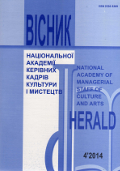ТЕОЛОГІЧНА КОНЦЕПЦІЯ ГАРМОНІЇ СУЩОГО: АТАРАКСІЯ ЯК ВОЛЕВИЯВЛЕННЯ
Theological concept of the harmony of things: ataraxia as the expression of the will
Author(s): Viktoria RudkoSubject(s): Ethics / Practical Philosophy, Ancient Philosphy, Philosophy of Middle Ages, Philosophy of Religion
Published by: Національна академія керівних кадрів культури і мистецтв
Keywords: ataraxia; harmony; logos; destiny; integrity; value;
Summary/Abstract: Ataraxia is an important subject of philosophical reflection. This term has a rather deep knowledge of harmonious spirit, being rooted in everyday life.The term "ataraxia" usually is associated with ethics of Greek philosophers who built their philosophical systems that provided an independent, calm and unemotional state for the individual. This measure, rhythm, harmony, and other categories of aesthetics are being converted from abstract common patterns of space into ways of self-studying and internal structure of a man. The category of ataraxia indicates integrity and orderliness of nature, balance of rational and emotional in man, feasibility of removal of social antagonisms. So it is always relevant.Stoicism was based on positions of subjectivity, and the objective things were pictured on the basis of subjective experiences. These experiences tell us about lekton in the most abstract form, and about ataraxia and apathy in the most exact form. Thus ataraxia could not come by itself, and apathy could be achieved only through great efforts. In the subjective field a human faces for some incomprehensible thicket of being, on the one hand and, on the other hand, the reasonableness of the code, the law of commandments, dictates, doctrines and all sorts of advice or systematically carried out arts of organization, design, reasonable, creative and artistic activity. A stoic wise man was such an artistic masterpiece in which everything is built methodically appropriate and according the precisely defined plan. In the Hellenistic era heroes were not born, they were brought up, taught, planned in advance. They knew what to expect and how to respond to this need. This is the era of subjectivity, that era of consciousness, the era of planned willpower, the era of pre-designed rules of artistic activity.In traditional presentation we also see the touch between the concepts of ataraxia and fate. In stoic philosophy the concept of fate is not the result of any faith or superstition, but it is a common notion, logically justified and therefore logically necessary. Stoic destiny is the semantic fluidity of meaning and love from other hand it is love to this sense of fluidity of meaning. Fate does everything what it needs; and it is the absolute fatalism. Man realizes himself as the result of the fate, as one of its artistic creations. It is turned out the fate realizes itself that acting freely, it is the instrument of fate. Therefore, it is important not to rebuild the reality, but to understand it. The stoic wise man does not resist evil. He understands it and being in its semantic fluidity that’s why he is calm.First of all stoicism was the morality, the developed to detail moral teaching, founded on special philosophical outlook. In this sense, it has the great educational value to the ancient world. Stoicism is a moral force that has great influence over many centuries and in large scale. It influenced on many teachers and fathers of the Church and Christianity in general.In the XVII century the rationalist borrowed and developed Stoic tradition on the new basis. It was based on the suggestion that the human mind can be the source and the foundation of the moral order and harmony. In philosophy and ethics of the XVII century reason is not a way of escaping from the world, but means of organization. It is the highest authority within the individual. It also resolutely subordinates all his passions, inclinations and interests. The mind does not balance passions, pointing out to everything on its place and time, but is committed to providing the entire human life in reasonable sense.The value of ataraxial state harmony characterized different worldviews, though in many aspects it remains little researched. For a detailed analysis of ataraxia as harmony, one can use the existential and axiological analysis of harmony by L. V. Baeva from the position of comparative and civilizational approach. The researcher believes that the concept of "harmony" is not limited solely by aesthetic and ethical spheres. It is a key ontological and anthropological category, which characterizes the way of mutual subordination of internal and external levels of the individual (society) being. In this sense references to harmony in the state of ataraxia means not only the emotional experience and sensual-figurative feeling of the fine as organically integrated, but also intuitive or rational ideas about the possibility of being a part existence not as "strange" component, but as a necessary component of a certain unity. This harmony as a property of the world and a way of its special perception characterizes ontological and epistemological distinctiveness of dual process of human and world relationships. Therefore, the harmony of ataraxia state as proportionality and balance of the internal and the external is a value of individual and social life reflecting the desire for wholeness, indivisible perception of the world. For many schools harmonization is a reflection of external universe with the inner world of the individual, which allows the merging with the "primary source" of all things.So, we can say that the ataraxia as the perception and support of harmony is the will and it turns to be removing a deep reflection about the dual, contradictory, twin foundations of the universe.
Journal: Вісник Національної академії керівних кадрів культури і мистецтв
- Issue Year: 2014
- Issue No: 4
- Page Range: 8-12
- Page Count: 5
- Language: Ukrainian

